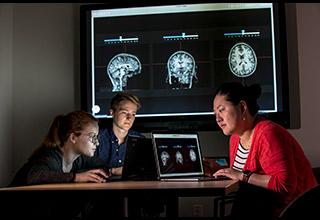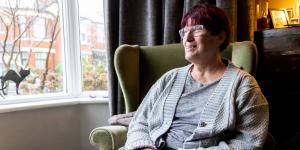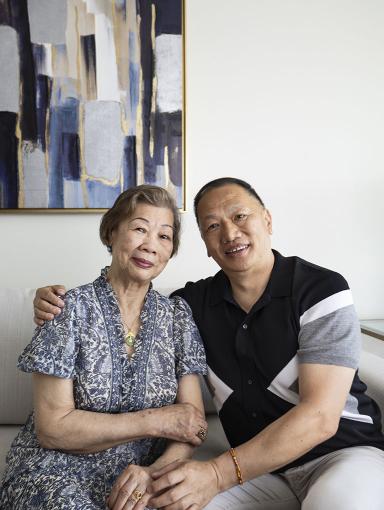The Study That Redefined How We View Strength Training and Aging
In the 1990s, two studies from Hebrew SeniorLife’s research institute defied assumptions about what older people are capable of.

In the 1990s, it was widely believed that strength training was dangerous for older people. While some research existed on strength training in healthy people in their 60s and 70s, there were almost no studies on significantly older adults with frailty in long-term care settings.
Hebrew SeniorLife’s research institute aimed to test that widespread belief through two studies led by Dr. Maria Fiatarone Singh. The studies explored the effects of strength training on long-term care residents in their 80s and 90s. The study results did more than challenge beliefs — they impacted how people view aging and strength!
Disproving beliefs about older people and strength training
In 1988, I was hired as a research associate for Hebrew SeniorLife. My original role was to recruit and train the participants who lived at Hebrew Rehabilitation Center.
Back then, the medical community feared that high-intensity strength training could lead to cardiovascular problems in older people with preexisting conditions. At the same time, there was a lack of data to validate those concerns. Even so, the myth prevailed. Because of that, we trained our study participants on proper breathing techniques and monitored their blood pressure and heart rate while they exercised.
The pilot study, conducted before I joined Hebrew SeniorLife, involved one strength exercise: the single-leg press. Muscle weakness in people with frailty is linked to repeated falls, and strength training could help with that muscle weakness. It would be groundbreaking if the study proved that strength training was a beneficial and safe intervention.
The results were terrific. Over just eight weeks of training, nine residents aged 87 to 96 showed an average strength increase of 174%! Researchers didn’t observe the cardiovascular problems that doctors feared.
Beyond the numbers, the real-world impacts were inspiring. People become stronger both physically and mentally. The results were profound enough to lead to a larger follow-up study.
We published our follow-up study in the New England Journal of Medicine in 1994. We explored whether resistance exercise training could improve strength, mobility, and overall function in 100 long-term care residents with an average age of 87. We randomly placed the study participants into groups, and those who were assigned high-intensity progressive resistance training did hip and knee extensions, which are muscle groups essential for functional activities.
Once again, we saw tremendous gains in those doing progressive resistance training, including a 113% average increase in leg strength, improved walking speed, stair climbing ability, and spontaneous physical activity.
I saw participants become able to do the things that matter most to them. One of the study's meaningful results was people’s ability to walk across the room better and participate in activities like going out with loved ones when they couldn’t before — seemingly simple activities that aren’t so simple when you’re missing out.
The real-world impact of our research
Because the changes we saw in older people were so remarkable, we received a lot of media attention, and our researchers were able to share our study results with the world. The takeaway that strength training's “risks” are safer for older people than the risks that come with frailty truly was revolutionary.
Beyond media attention, we started examining how our fitness facilities were set up and what we could improve. One aspect of working at Hebrew SeniorLife that I appreciate is that we not only do research but are also committed to putting that research into clinical practice when it will improve the quality of life for our patients and residents. When our administration found out the results were significant for our long-term care residents, they sprang into action to implement it.
I assisted in implementing one of the biggest exercise facilities at Orchard Cove in Canton, MA, and expanding what we already had at NewBridge on the Charles in Dedham, MA. I also helped set up the exercise equipment at Center Communities of Brookline, before the location was even under the Hebrew SeniorLife umbrella!
After our research was published, there was a massive burst of interest from other senior living organizations, and facilities wanted to ensure they offered what residents were looking for. Owners of innovative communities came to visit to see what we offered, and I would sometimes go to them to help them set up fitness facilities as well. I even got invited to Japan to conduct a lecture on strength training and visit a nursing home to offer suggestions on modifying an exercise facility without machines.
Additionally, the research continues to inspire. The follow-up study has been cited in over 4,000 additional studies, and that number continues to grow. Michael Joseph Gross also recently discussed the study in his book Stronger: The Untold Story of Muscle in Our Lives.
We were truly pioneers in the field of strength training for older adults. What began as one pilot study helped redefine the standards for aging and exercise, helping many older adults live with more strength and independence.
The work to shift the narrative continues
While a cultural shift was apparent, there’s still room for growth! A 2020 literature review on ageism in the health and fitness industry found that ageism can hold older adults back from engaging in physical activity. Often, that ageism comes from fitness trainers with outdated views on what older people are capable of.
At Hebrew SeniorLife, we are dedicated to our work to shift this narrative. Through Get Up & Go, our personalized exercise program for older adults, we encourage older adults of all ability levels to participate in safe exercise.
Hebrew Rehabilitation Center’s Get Up & Go exercise program involves a comprehensive fitness evaluation by exercise physiologists specializing in fitness for older adults. They will then develop a personalized exercise program made just for you! Get Up & Go focuses on progressive strength training, balance, and endurance or cardiovascular training. It is a testament that people in their 80s and beyond can join an exercise program and thrive.
Personalized exercise programs for older adults at Hebrew SeniorLife
Are you interested in discovering how our personalized exercise program can benefit you? Contact us online or call 617-363-8284 today to learn more about Get Up & Go.
Join Our Community: Subscribe to the Hebrew SeniorLife blog for weekly insights on healthy aging and senior living.
Blog Topics
Learn More
Senior Fitness
Our exercise physiologists specialize in fitness for older adults and will develop a personalized exercise program for you.
Research on Aging
At the Hinda and Arthur Marcus Institute for Aging Research, Harvard Medical School-affiliated researchers are working to uncover answers to some of the most pressing challenges of aging.





